Birds of Game Abundances in Evergreen Forests in Calakmul Biosphere Reserve, Campeche, Mexico
Simple Summary
Abstract
1. Introduction
2. Materials and Methods
2.1. Study Area
2.2. Camera Trap Monitoring
2.3. Data Analysis
3. Results
4. Discussion
5. Conclusions
Author Contributions
Funding
Institutional Review Board Statement
Informed Consent Statement
Data Availability Statement
Acknowledgments
Conflicts of Interest
References
- Escalante, P.; Navarro-Sigüenza, A.G.; Peterson, A.T. Un análisis geográfico, ecológico e histórico de la diversidad de aves terrestres de México. In Diversidad Biológica de México: Orígenes y Distribución; Ramamoorthy, T.P., Bye, R., Lot, A., Fa, J., Eds.; Universidad Nacional Autónoma de México, Instituto de Biología: Mexico City, Mexico, 1998; pp. 279–304. [Google Scholar]
- Sánchez, O.; Pérez-Hernández, R. Historia y tabla de equivalencias de las propuestas de subdivisiones biogeográficas de la región Neotropical. In Regionalización Biogeográfica en Iberoamérica y Tópicos Afines; Llorente-Bousquets, J., Morrone, J.J., Eds.; Primeras Jornadas Biogeográficas de la Red Iberoamericana de Biogeografía y Entomología Sistemática (RIBES XII.ICYTED); Las Prensas de Ciencias, UNAM: Mexico City, Mexico, 2005. [Google Scholar]
- Berlanga, H.; Rodríguez-Contreras, V.; Oliveras de Ita, A.; Escobar, M.; Rodríguez, L.; Vieyra, J.; Vargas, V. Red de Conocimiento Sobre las Aves de México (AVESMX); CONABIO: Mexico City, Mexico, 2008. [Google Scholar]
- Reyna-Hurtado, R.; Sima-Panti, D.; Andrade, M.; Padilla, A.; Retana-Guaiscon, O.; Sánchez-Pinzón, K.; Wilber, M.; Ninón, M.; Moreira-Ramírez, J.F.; Carrillo-Reyna, N.; et al. Tapir population patterns under the disappearance of free-standing water. Therya 2019, 10, 353. [Google Scholar] [CrossRef]
- González-Jaramillo, M.; Martínez, E.; Esparza-Olguín, L.G.; Rangel-Salazar, J.L. Actualización del inventario de la avifauna de la Reserva de la Biosfera de Calakmul, península de Yucatán, México: Abundancia, estacionalidad y categoría de conservación. Huitzil 2016, 17, 54–106. [Google Scholar] [CrossRef]
- Delacour, J.; Amadon, D. Curassows and Related Birds; American Museum of Natural History: New York, NY, USA, 1973. [Google Scholar]
- Sibley, C.G.; Monroe, B. Distribution and Taxonomy of Birds of the World; Yale University Press: New Haven, CT, USA, 1990. [Google Scholar]
- Vannini, J.P.; Rockstroh, P.M. The status of cracids in Guatemala. In The Cracidae: Their Biology and Conservation; Strahl, S.D., Beaujon, S., Brooks, D.M., Begazo, A.J., Sedaghatkish, G., Olmos, F., Eds.; Hancock House Publishers: Surrey, BC, Canada; Blaine, WA, USA, 1997; pp. 326–334. [Google Scholar]
- Calmé, S.; Sanvicente, M. Distribución Actual, Estado Poblacional y Evaluación del Estado de Protección del Pavo Ocelado (Agriocharis ocellata); Final Report of Project R114 to Comisión Nacional para el Conocimiento y Uso de la Biodiversidad; Comisión Nacional para el Conocimiento y Uso de la Biodiversidad: Mexico City, Mexico, 2000. [Google Scholar]
- Santos-Fita, D.; Naranjo, E.J.; Rangel-Salazar, J.L. Wildlife uses and hunting patterns in rural communities of the Yucatan Peninsula, Mexico. J. Ethnobiol. Ethnomed. 2012, 8, 38. [Google Scholar] [CrossRef]
- López-Castilla, H.M.; Cetzal-Ix, W.; Noguera-Savelli, E.; Basu, S.K.; Contreras-Moreno, F.M. A review of wildlife used by the Mayan communities in areas close to the nature reserves in the Yucatán Peninsula region, Mexico. Discov. Conserv. 2024, 1, 12. [Google Scholar] [CrossRef]
- Howell, S.N.G.; Webb, S. A Guide to the Birds of Mexico and Northern Central America; Oxford University Press: Oxford, UK, 1995. [Google Scholar]
- Secretaría de Medio Ambiente y Recursos Naturales. Norma Oficial Mexicana NOM-059-SEMARNAT-2010, Protección Ambiental—Especies Nativas de México de Flora y Fauna Silvestres—Categorías de Riesgo y Especificaciones para su Inclusión, Exclusión o Cambio—Lista de Especies en Riesgo. 2010. Available online: https://www.dof.gob.mx/nota_detalle.php?codigo=5173091&fecha=30/12/2010 (accessed on 30 December 2010).
- BirdLife International. Crax rubra . In Lista Roja de Especies Amenazadas de la UICN; Version 2024-1; IUCN: Gland, Switzerland, 2020; Available online: http://www.iucnredlist.org (accessed on 7 October 2024).
- BirdLife International. Meleagris ocellata . In Lista Roja de Especies Amenazadas de la UICN; Version 2024-1; IUCN: Gland, Switzerland, 2020; Available online: https://www.iucnredlist.org/es/species/22679529/178204994 (accessed on 7 October 2024).
- García-Gil, G.; Palacio-Prieto, J.L.; Ortiz-Pérez, M.A. Reconocimiento geomorfológico e hidrográfico de la Reserva de la Biosfera Calakmul, México. Investig. Geogr. 2002, 48, 7–23. [Google Scholar]
- Martínez, E.; Galindo-Leal, C. La vegetación de Calakmul, Campeche, México: Clasificación, descripción y distribución. Bol. Soc. Bot. México 2002, 71, 7–32. [Google Scholar] [CrossRef]
- Martínez-Kú, D.H.; Escalona-Segura, G.; Vargas-Contreras, J.A. Importancia de las aguadas para los mamíferos de talla mediana y grande en Calakmul, Campeche, México. In Avances en el Estudio de los Mamíferos II; Asociación Mexicana de Mastozoología A.C.: Mexico City, Mexico, 2008; pp. 449–468. [Google Scholar]
- Peres, C.A. General guidelines for standardizing line-transect surveys of tropical forest primates. Neotrop. Primates 1999, 7, 11–16. [Google Scholar] [CrossRef]
- Borges-Zapata, J.Y.; Contreras-Moreno, F.M.; Serrano-MacGregor, I.; Sima-Pantí, D.E.; Coutiño-Cal, C.; Zúñiga-Morales, J.A.; Duque-Moreno, V.D.; Hernández-Pérez, E.L.; López-Chan, J.A. Uso de bebederos artificiales por el sereque centroamericano (Dasyprocta punctata) en la reserva de la biosfera de Calakmul, México. Agro Product. 2020, 13, 51–58. [Google Scholar] [CrossRef]
- Niedballa, J.; Courtiol, A.; Sollmann, R.; Mathai, J.; Wong, S.T.; Truong, A.; Mohamed, A.; Tilker, A.; Wilting, A. CamtrapR Package. Camera Trap Data Management and Preparation of Occupancy and Spatial Capture-Recapture Analyses. Available online: https://cran.r-project.org/web/packages/camtrapR/camtrapR.pdf (accessed on 9 October 2024).
- Seifert, E. OriginPro 9.1: Scientific data analysis and graphing software—Software review. J. Chem. Inf. Model. 2014, 54, 1552. [Google Scholar] [CrossRef] [PubMed]
- McGarigal, K.; Cushman, S.A.; Stafford, S. Multivariate Statistics for Wildlife and Ecology Research; Springer Science & Business Media: New York, NY, USA, 2013. [Google Scholar]
- The Jamovi Project. Jamovi, Version 2.3. 2022. Available online: https://www.jamovi.org (accessed on 9 October 2024).
- Silverio-Polo, L.; Ramírez-Bravo, O.E.; Ordóñez-Prado, C.; Vázquez, G.O. New records of Cracids along a fragmented landscape in Central Mexico (Aves Cracidae). Biodivers. J. 2018, 9, 339–344. [Google Scholar] [CrossRef]
- Hogan, E. Structure of a Lowland Neotropical Galliform Bird Guild. Master’s Thesis, University of Florida, Florida, FL, USA, 2008. [Google Scholar]
- Balam-Castro, A.; Yam-Chin, C.A.; Canul-Solís, M.; Reyna-Díaz, J. Los agroecosistemas tropicales y su contribución en la alimentación del pavo ocelado (Meleagris ocellata Cuvier). In Agroecosistemas Tropicales: Conservación de Recursos y Seguridad Alimentaria; Cetzal-Ix, W.R., Casanova-Lugo, F., Chay-Canu, A.J., Martínez-Puc, J.F., Eds.; Tecnológico Nacional de México, Instituto Tecnológico de Chiná—Instituto Tecnológico de la Zona Maya: Mexico City, Mexico, 2019; p. 533. [Google Scholar]
- Calmé, S.; Guerra, R.M.; Xijun, K.M.; Manzón-Che, M. Cacería. In Uso y Monitoreo de los Recursos Naturales en el Corredor Biológico Mesoamericano (Áreas Focales Xpujil-Zoh Laguna y Carrillo Puerto); Vester, H.F.M., Pozo-de la Tijera, M.C., Calmé, S., Eds.; Comisión Nacional para el Uso y Conocimiento de la Biodiversidad (CONABIO): Mexico City, Mexico, 2024. [Google Scholar]
- González, M.J.; Quigley, H.B.; Taylor, C.I. Habitat use, reproductive behavior, and survival of ocellated turkeys in Tikal National Park, Guatemala. Wilson Bull. 1998, 110, 505–510. [Google Scholar]
- Martin, T.H.; Buchholz, R. Implications of male breeding-season home range movements for population monitoring and minimum reserve area of the Ocellated Turkey (Meleagris ocellata), a threatened Yucatán endemic. Condor Ornithol. Appl. 2018, 120, 815–827. [Google Scholar] [CrossRef]
- Urquiza-Haas, T.; Peres, C.A.; Dolman, P.M. Large vertebrate responses to forest cover and hunting pressure in communal landholdings and protected areas of the Yucatan Peninsula, Mexico. Anim. Conserv. 2011, 14, 271–282. [Google Scholar] [CrossRef]
- Chaves-Campos, J. Changes in abundance of Crested Guan (Penelope purpurascens) and Black Guan (Chamaepetes unicolor) along an altitudinal gradient in Costa Rica. Ornitol. Neotrop. 2003, 14, 195–200. [Google Scholar]
- Whitworth, A.; Beirne, C.; Flatt, E.; Huarcaya, R.P.; Cruz, J.C.; Forsyth, A.; Molnár, P.K.; Vargas-Soto, J.S. Secondary forest is utilized by Great Curassows (Crax rubra) and Great Tinamous (Tinamus major) in the absence of hunting. Condor 2018, 120, 852–862. [Google Scholar] [CrossRef]
- Ceballos, G.; Márquez-Valdelamar, L. Las Aves de México en Peligro de Extinción; Instituto de Ecología, UNAM, CONABIO y FCE: Mexico City, Mexico, 2008. [Google Scholar]
- López, R.R.; Silvy, N.J.; Peterson, M.J.; Baur, E.H.; González-García, F.; Brooks, D.M. Chachalacas, hocofaisanes y pavas. In Ecología y Manejo de Fauna Silvestre en México; Valdez, R., Ortega, A., Eds.; Colegio de Postgraduados, Univ. Autónoma de Chapingo, Instituto Interamericano de Cooperación para la Agricultura: Texcoco, Mexico, 2014; pp. 121–145. [Google Scholar]
- Rivas, J.A. Preferencias Alimenticias del Faisan o Pajuil (Crax rubra rubra L.) en Condiciones Naturales. Bachelor’s Thesis, Universidad de San Carlos, Facultad de Ciencias Químicas y Farmacia, Ciudad de Guatemala, Guatemala, 1995; p. 66. [Google Scholar]
- Carroll, J.M.; Davis, C.A.; Elmore, R.D.; Fuhlendorf, S.D. A ground-nesting galliform’s response to thermal heterogeneity: Implications for ground-dwelling birds. PLoS ONE 2015, 10, e0143676. [Google Scholar] [CrossRef]
- Lavariega, M.C.; Monroy-Gamboa, A.G.; Padilla-Gómez, E.; Olivera-Martínez, U. Patrones de actividad de la chachalaca pálida (Ortalis poliocephala). Huit. Rev. Mex. Ornitol. 2019, 20, e536. [Google Scholar] [CrossRef][Green Version]
- Pérez-Irineo, G.; Santos-Moreno, A. Bird activity patterns in the understory of an evergreen forest in Oaxaca, Mexico. Neotrop. Biol. Conserv. 2021, 16, 1–10. [Google Scholar] [CrossRef]
- Lafleur, L.; Pardo, L.E.; Spínola, R.M.; Saénz, J.C.; Cove, M.V. Notes on plumage patterns and activity of the Great Curassow (Crax rubra) in northeastern Costa Rica. Bull. Cracid Group Gall. Spec. Group 2014, 36, 17–19. [Google Scholar]
- Delgado-Martínez, C.M.; Alvarado, F.; Mendoza, E.; Flores-Hernández, S.; Navarrete, A.; Navarrete, E.; Botello, F. An ignored role of sartenejas to mitigate water shortage hazards for tropical forest vertebrates. Ecology 2018, 99, 758–760. [Google Scholar] [CrossRef]
- Delgado-Martínez, C.M.; Kolb, M.; Pascual-Ramírez, F.; Mendoza, E. Differential utilization of surface and arboreal water bodies by birds and mammals in a seasonally dry Neotropical forest in southern Mexico. Ecol. Evol. 2023, 13, e10781. [Google Scholar] [CrossRef] [PubMed]
- Kampichler, C.; Calmé, S.; Weissenberger, H.; Arriaga-Weiss, S.L. Indication of a species in an extinction vortex: The ocellated turkey on the Yucatan Peninsula, Mexico. Acta Oecologica 2010, 36, 561–568. [Google Scholar] [CrossRef]
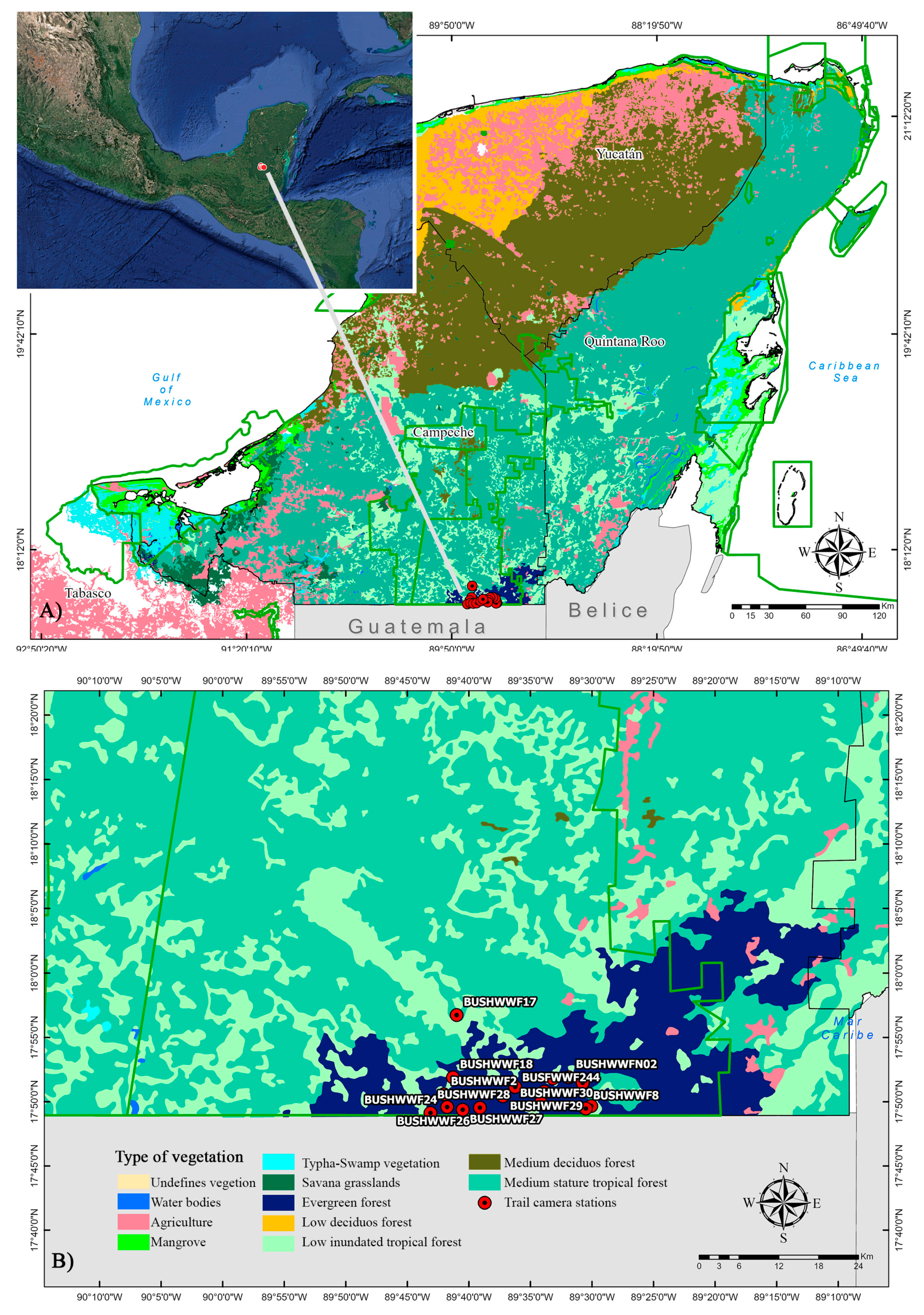
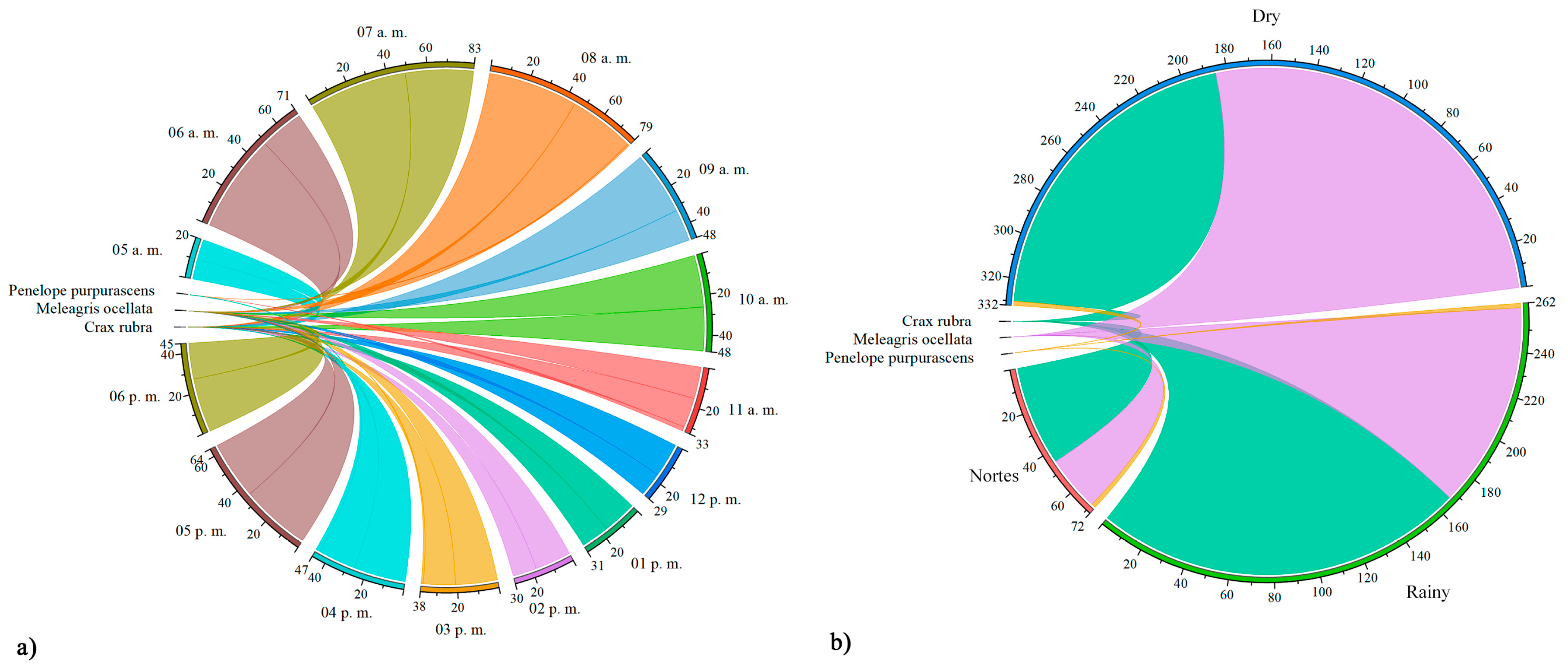
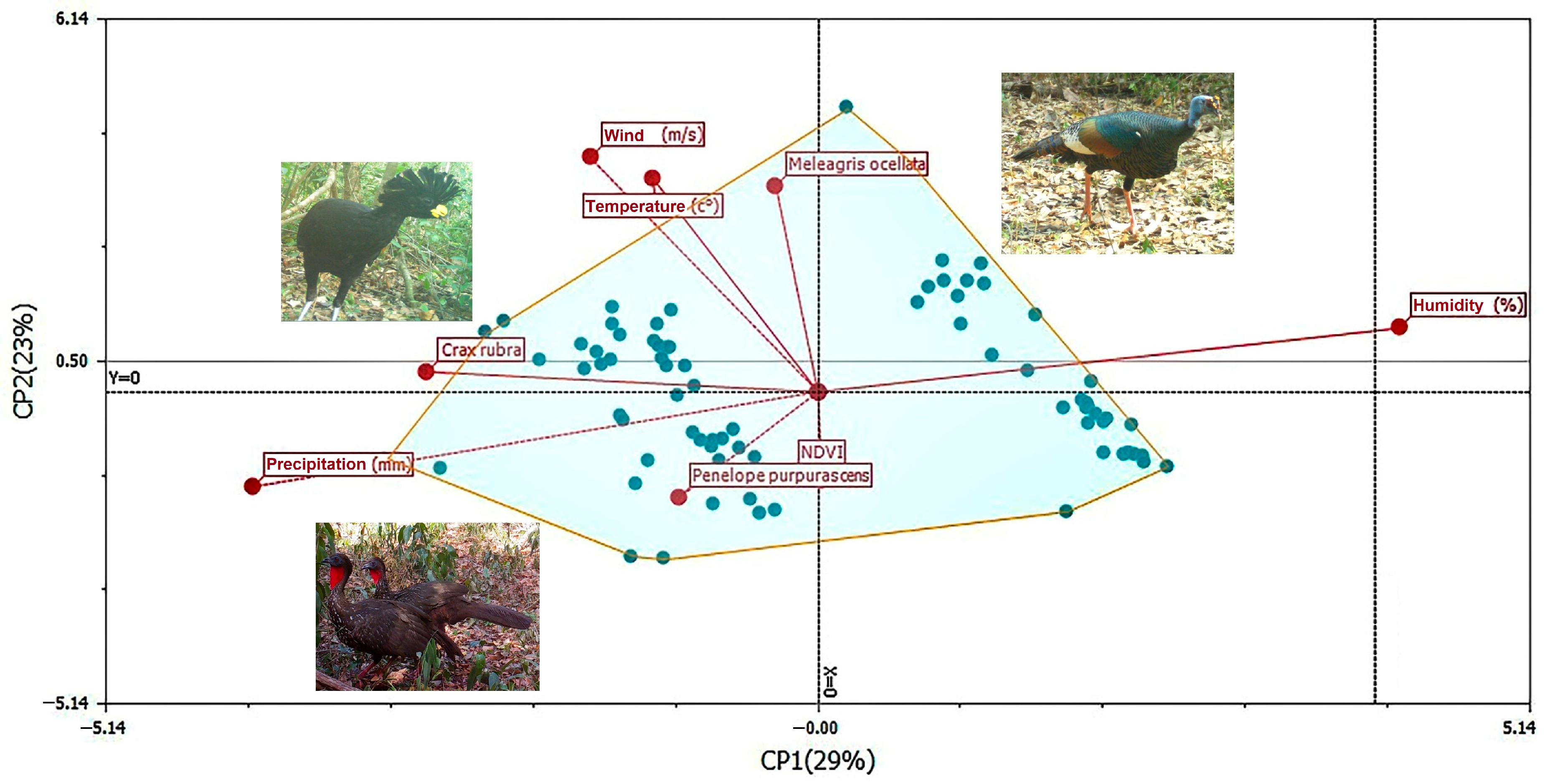
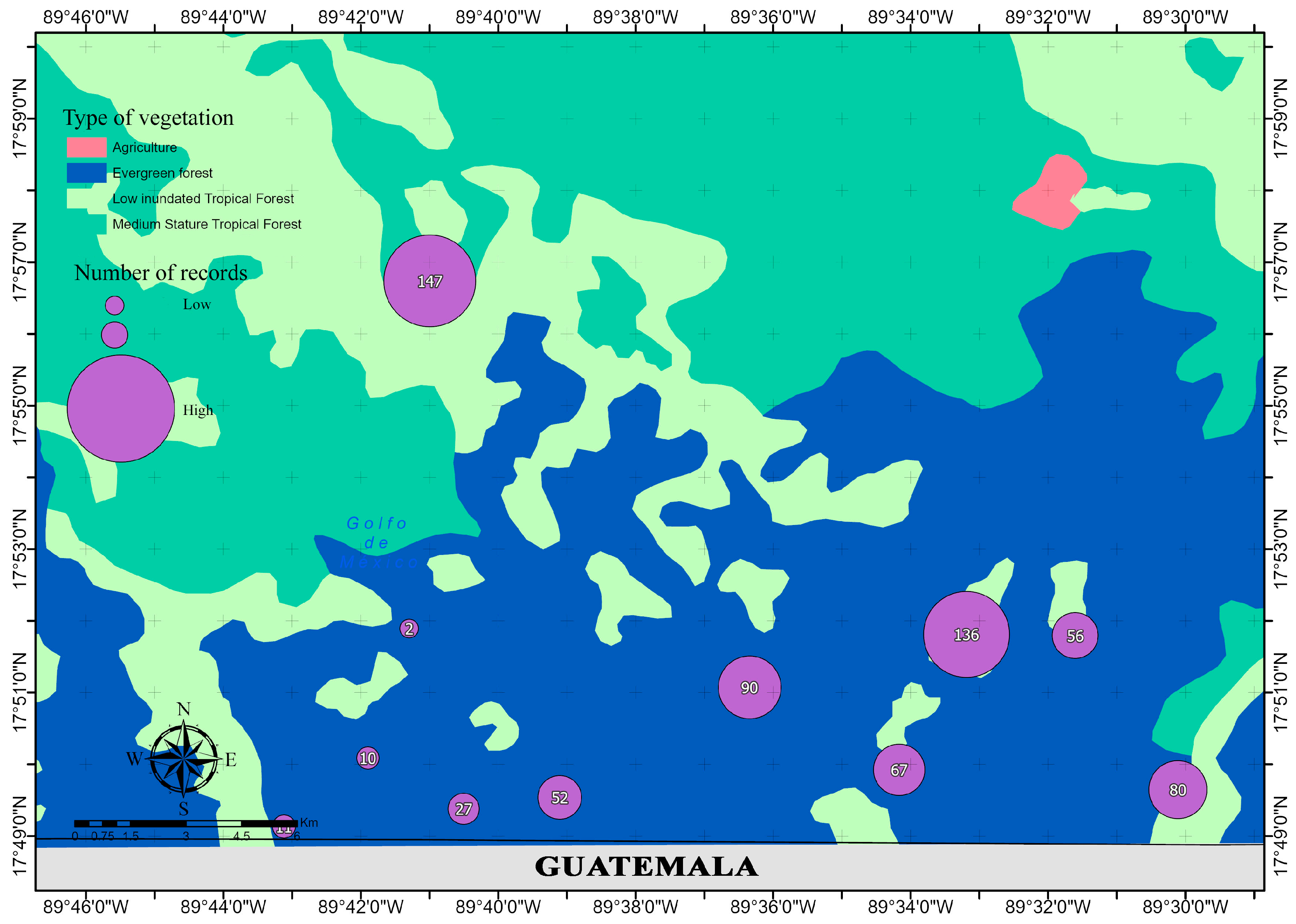

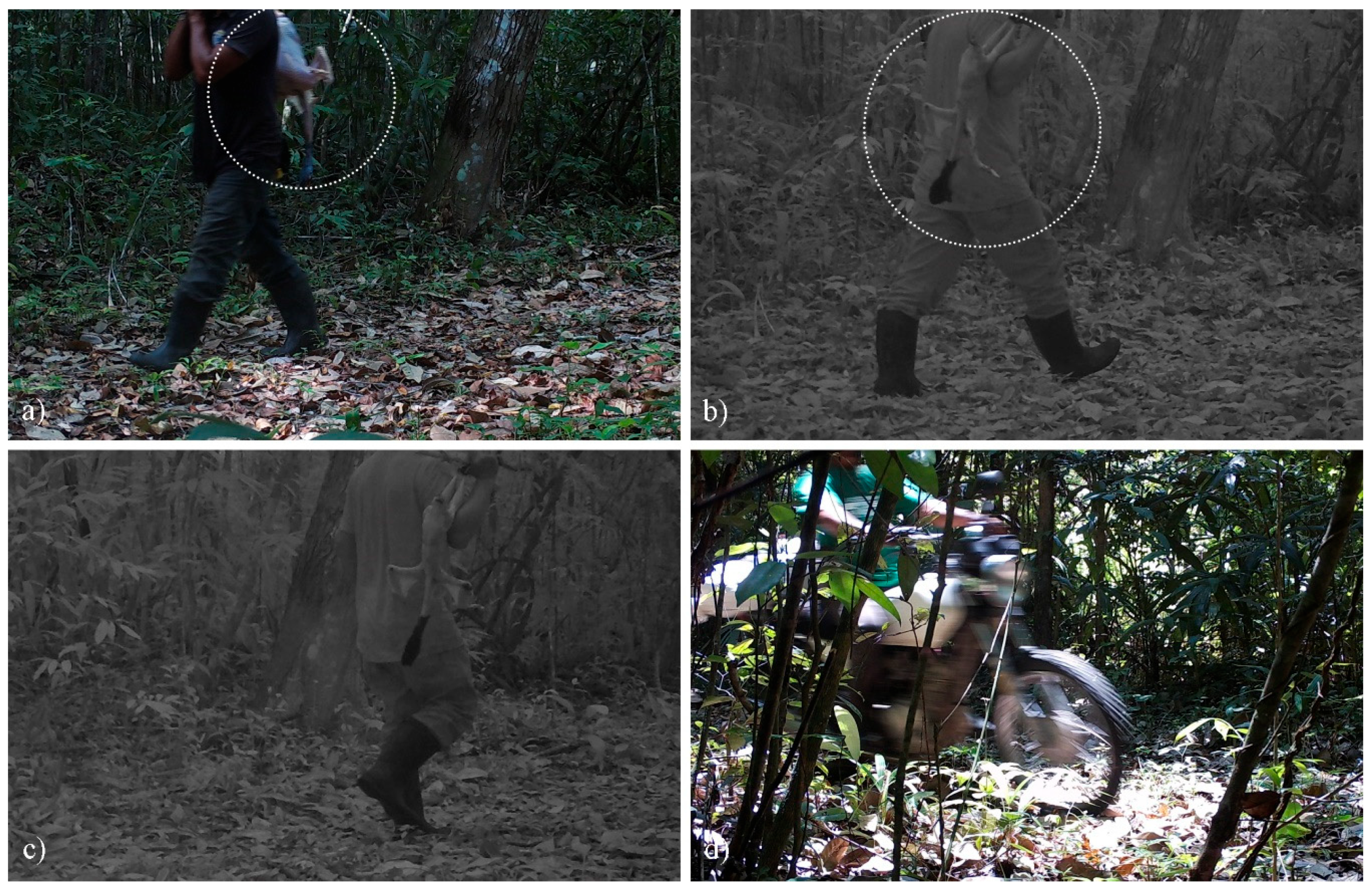
| Species | Evergreen Forest | Medium Stature Tropical Forest | Abundances | Mean ± Standard Error |
|---|---|---|---|---|
| Crax rubra | 308 | 49 | 357 | 22.31 ± 5.98 |
| Meleagris ocellata | 163 | 140 | 303 | 18.93 ± 7.19 |
| Penelope purpurascens | 6 | 0 | 6 | 0.37 ± 0.15 |
Disclaimer/Publisher’s Note: The statements, opinions and data contained in all publications are solely those of the individual author(s) and contributor(s) and not of MDPI and/or the editor(s). MDPI and/or the editor(s) disclaim responsibility for any injury to people or property resulting from any ideas, methods, instructions or products referred to in the content. |
© 2025 by the authors. Licensee MDPI, Basel, Switzerland. This article is an open access article distributed under the terms and conditions of the Creative Commons Attribution (CC BY) license (https://creativecommons.org/licenses/by/4.0/).
Share and Cite
López-Castilla, H.M.J.; Contreras-Moreno, F.M.; Jesús-Espinosa, D.; Méndez-Tun, J.M.; Sánchez-Pinzón, K.; Bautista-Ramírez, P.; Cruz-Romo, L.; Petrone, S. Birds of Game Abundances in Evergreen Forests in Calakmul Biosphere Reserve, Campeche, Mexico. Wild 2025, 2, 3. https://doi.org/10.3390/wild2010003
López-Castilla HMJ, Contreras-Moreno FM, Jesús-Espinosa D, Méndez-Tun JM, Sánchez-Pinzón K, Bautista-Ramírez P, Cruz-Romo L, Petrone S. Birds of Game Abundances in Evergreen Forests in Calakmul Biosphere Reserve, Campeche, Mexico. Wild. 2025; 2(1):3. https://doi.org/10.3390/wild2010003
Chicago/Turabian StyleLópez-Castilla, Héctor M. J., Fernando M. Contreras-Moreno, Daniel Jesús-Espinosa, José M. Méndez-Tun, Khiavett Sánchez-Pinzón, Pedro Bautista-Ramírez, Lizardo Cruz-Romo, and Sandra Petrone. 2025. "Birds of Game Abundances in Evergreen Forests in Calakmul Biosphere Reserve, Campeche, Mexico" Wild 2, no. 1: 3. https://doi.org/10.3390/wild2010003
APA StyleLópez-Castilla, H. M. J., Contreras-Moreno, F. M., Jesús-Espinosa, D., Méndez-Tun, J. M., Sánchez-Pinzón, K., Bautista-Ramírez, P., Cruz-Romo, L., & Petrone, S. (2025). Birds of Game Abundances in Evergreen Forests in Calakmul Biosphere Reserve, Campeche, Mexico. Wild, 2(1), 3. https://doi.org/10.3390/wild2010003







